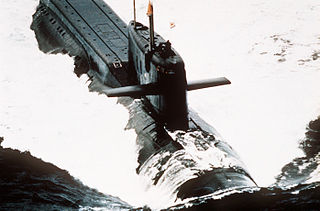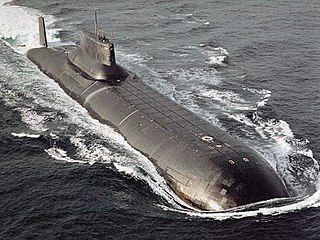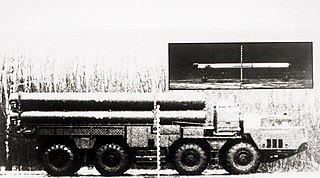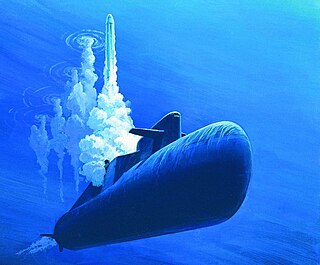Users
 Soviet Union
Soviet Union
| R-31/RSM-45 | |
|---|---|
| Type | Submarine-launched ballistic missile |
| Place of origin | Soviet Union |
| Service history | |
| Used by | See Users |
| Production history | |
| Designer | Arsenal Design Bureau |
| Manufacturer | Arsenal Design Bureau |
| Variants | See Variants |
| Specifications | |
| Maximum firing range | 4,500 km |
RSM-45R-31 [1] (NATO designation - SS-N-17 Snipe) was a Soviet submarine-launched ballistic missile. [2] [3]
Development for the missile began in June 1971 at the Arsenal Design Bureau. [4] It was fitted on only one Yankee II class submarine, originally for evaluation purposes. A first test flight took place from the Yankee II Class submarine K-140 (photo) in December 1976. [1] The RS-16 was the first solid-fueled ICBM in the Soviet Union's strategic arsenal. It was a two-stage delivery device armed with a single 500 kt nuclear warhead. A particular practical benefit of the design was the quiet submerged launch system, which used the missile's own buoyancy to lift it to the surface.
The missile entered service in March 1980, [1] but was never installed in any other submarine other than the K-140, and was out of service by 1991. Apparently this missile was also capable of performing the duties of SLCMs, as the targeting distance could be varied drastically.
It was the first Soviet ballistic missile using astro-inertial guidance.

A submarine-launched ballistic missile (SLBM) is a ballistic missile capable of being launched from submarines. Modern variants usually deliver multiple independently targetable reentry vehicles (MIRVs), each of which carries a nuclear warhead and allows a single launched missile to strike several targets. Submarine-launched ballistic missiles operate in a different way from submarine-launched cruise missiles.

A ballistic missile submarine is a submarine capable of deploying submarine-launched ballistic missiles (SLBMs) with nuclear warheads. The United States Navy's hull classification symbols for ballistic missile submarines are SSB and SSBN – the SS denotes submarine, the B denotes ballistic missile, and the N denotes that the submarine is nuclear powered. These submarines became a major weapon system in the Cold War because of their nuclear deterrence capability. They can fire missiles thousands of kilometers from their targets, and acoustic quieting makes them difficult to detect, thus making them a survivable deterrent in the event of a first strike and a key element of the mutual assured destruction policy of nuclear deterrence.

The R-39 Rif was a submarine-launched ballistic missile (SLBM) that served with the Soviet Navy from its introduction in 1983 until 1991, after which it served with the Russian Navy until 2004. The missile had GRAU indices of 3M65, 3M20, and 3R65. It was carried on board Typhoon-class submarines.

The Yankee class, Soviet designations Project 667A Navaga (navaga) and Project 667AU Nalim (burbot), was a series of nuclear-powered ballistic missile submarines built in the Soviet Union for the Soviet Navy. In total, 34 units were built: 24 in Severodvinsk for the Northern Fleet and the remaining 10 in Komsomolsk-on-Amur for the Pacific Fleet. Two Northern Fleet units were later transferred to the Pacific. The lead boat K-137 Leninets received its honorific name on 11 April 1970, two and one half years after being commissioned.

The Typhoon class, Soviet designation Project 941 Akula, is a class of nuclear-powered ballistic missile submarines designed and built by the Soviet Union for the Soviet Navy. With a submerged displacement of 48,000 tonnes, the Typhoons are the largest submarines ever built, able to accommodate comfortable living facilities for the crew of 160 when submerged for months on end. The source of the NATO reporting name remains unclear, although it is often claimed to be related to the use of the word "typhoon" ("тайфун") by General Secretary Leonid Brezhnev of the Communist Party in a 1974 speech while describing a new type of nuclear ballistic missile submarine, as a reaction to the United States Navy's new Ohio-class submarine.

K-407 Novomoskovsk is a Project 667BDRM Delfin-class ballistic missile submarine of the Russian Navy's Northern Fleet.

The R-27 Zyb was a submarine-launched ballistic missile developed by the Soviet Union and employed by the Soviet Navy from 1968 through 1988. NATO assigned the missile the reporting name SS-N-6 Serb. In the USSR, it was given the GRAU index 4K10. It was a liquid fuel rocket using a hypergolic combination of unsymmetrical dimethylhydrazine (UDMH) as fuel, and nitrogen tetroxide (NTO) as oxidizer. Between 1974 and 1990, 161 missile launches were conducted, with an average success rate of 93%. Total production was 1800 missiles.
R-29 Vysota Р-29 Высота is a family of Soviet submarine-launched ballistic missiles, designed by Makeyev Rocket Design Bureau. All variants use astro-inertial guidance systems.

The Delta class, Soviet designations Project 667B Murena, Project 667BD Murena-M, Project 667BDR Kalmar, Project 667BDRM Delfin, are a series of third generation nuclear-powered ballistic missile submarines, designed and built in the Soviet Union, which formed the backbone of the Soviet and Russian strategic submarine fleet since their introduction in 1973. They carry nuclear ballistic missiles of the R-29 Vysota family, with the Delta I, Delta II, Delta III and Delta IV classes carrying the R-29, R-29D, R-29R and R-29RM respectively. The Delta I class carried 12 missiles, while the Delta II class which are lengthened versions of the Delta I class carry 16 missiles. The Delta III and Delta IV classes carry 16 missiles with multiple warheads and have improved electronics and noise reduction.

The R-21 was a submarine-launched ballistic missile in service with the Soviet Union between 1963 and 1989. It was the first Soviet nuclear missile that could be launched from a submerged submarine, and also had twice the range of earlier missiles. It replaced the R-11FM and R-13 (SS-N-4) on many Golf and Hotel-class submarines, and was in turn superseded by the R-27 missile carried by Yankee-class submarines.
The Delta III-class submarine, Soviet designation Project 667BDR Kaľmar (Squid), is a large ballistic missile submarine operated by the Russian Navy. Like other previous Delta-class submarines, the Delta III class is a double hulled design, with a thin low magnetic steel outer hull wrapped around a thicker inner pressure hull.

The R-29RM Shtil was a liquid propellant, submarine-launched ballistic missile in use by the Russian Navy. It had the alternate Russian designations RSM-54 and GRAU index 3M27. It was designed to be launched from the Delta IV submarine, each of which is capable of carrying 16 missiles. The R-29RM could carry four 100 kiloton warheads and had a range of about 8,500 kilometres (5,300 mi). They were replaced with the newer R-29RMU2 Sineva and later with the enhanced variant R-29RMU2.1 Layner.

The RSM-56 Bulava is a submarine-launched ballistic missile (SLBM) developed for the Russian Navy and deployed in 2013 on the new Borei class of ballistic missile nuclear submarines. It is intended as the future cornerstone of Russia's nuclear triad, and is the most expensive weapons project in the country. The weapon takes its name from bulava, a Russian word for mace.

The Main Missile and Artillery Directorate of the Ministry of Defense of the Russian Federation, commonly referred to by its transliterated Russian acronym GRAU (ГРАУ), is a department of the Russian Ministry of Defense. It is subordinate to the Chief of Armament and Munition of the Russian Armed Forces, a vice-minister of defense.

A nuclear triad is a three-pronged military force structure that consists of land-launched nuclear missiles, nuclear-missile-armed submarines, and strategic aircraft with nuclear bombs and missiles. Specifically, these components are land-based intercontinental ballistic missiles (ICBMs), submarine-launched ballistic missiles (SLBMs), and strategic bombers. The purpose of having this three-branched nuclear capability is to significantly reduce the possibility that an enemy could destroy all of a nation's nuclear forces in a first-strike attack. This, in turn, ensures a credible threat of a second strike, and thus increases a nation's nuclear deterrence.

The R-29RMU2 Sineva, code RSM-54, is a Russian liquid-fueled submarine-launched ballistic missile with GRAU index 3M27, designation SS-N-23A Skiff. It can carry four warheads and is designed to be launched from Delta IV class submarines, which are armed with 16 missiles each. As of 2017, there are 96 launchers deployed on the submarines.

The Novator RK-55 Relief is a Russian land-based and submarine-launched cruise missile with a nuclear warhead developed in the Soviet Union. It was about to enter service in 1987, when such weapons were banned under the Intermediate-Range Nuclear Forces Treaty. A version launched from submarine torpedo tubes, the S-10 Granat, has apparently been converted to carry conventional warheads and continues in service to this day. The Russian Federation was reported to have deployed the derivative SS-CX-7/SS-CX-8 systems on February 14, 2017.

Operation Behemoth-1, Behemoth-2 were military exercises held by the Soviet Northern Fleet in 1989 and 1991. Behemoth-2 was the first time ever when a ballistic missile submarine launched all of its missiles at once.
The R-29RMU2.1 Layner is a Russian liquid-fuelled submarine-launched ballistic missile (SLBM) and the newest member of the R-29 missile family, developed by the Makeyev Rocket Design Bureau and produced by the Krasnoyarsk Machine-Building Plant. Derived from the R-29RMU2 Sineva SLBM, the Layner can carry twelve nuclear warheads, three times as many as Sineva. It was expected to enter service with the Russian Navy's Delta IV class submarines after a successful test programme that spanned from May to September 2011. The Russian Navy confirmed in 2014 that the system was now in use.